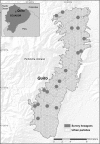Explaining Accessibility and Satisfaction Related to Healthcare: A Mixed-Methods Approach
- PMID: 28890596
- PMCID: PMC5569143
- DOI: 10.1007/s11205-016-1371-9
Explaining Accessibility and Satisfaction Related to Healthcare: A Mixed-Methods Approach
Abstract
Accessibility and satisfaction related to healthcare services are conceived as multidimensional concepts. These concepts can be studied using objective and subjective measures. In this study, we created two indices: a composite healthcare accessibility index (CHCA) and a composite healthcare satisfaction index (CHCS). To calculate the CHCA index we used three indicators based on three components of multidimensional healthcare accessibility: availability, acceptability and accessibility. In the indicator based on the component of accessibility, we included an innovative perceived time-decay parameter. The three indicators of the CHCA index were weighted through the application of a principal components analysis. To calculate the CHCS index, we used three indicators: the waiting time after the patient arrives at the healthcare service, the quality of the healthcare, and the healthcare service supply. These three indicators making up the CHCA index were weighted by applying an analytical hierarchy process. Three kinds of regressions were subsequently applied in order to explain the CHCA and CHCS indices: namely the Linear Least Squares, Ordinal Logistic, and Random Forests regressions. In these regressions, we used different independent social and health-related variables. These variables represented the predisposing, enabling, and need factors of people´s behaviors related to healthcare. All the calculations were applied to a study area: the city of Quito, Ecuador. Results showed that there are health-related inequalities in regard to healthcare accessibility and healthcare satisfaction in our study area. We also identified specific social factors that explained the indices developed. The present work is a mixed-methods approach to evaluate multidimensional healthcare accessibility and healthcare satisfaction, incorporating a pluralistic perspective, as well as a multidisciplinary framework. The results obtained can also be considered as tools for healthcare and urban planners, for more integrative social analyses that can improve the quality of life in urban residents.
Keywords: Accessibility; Composite index; Healthcare; Satisfaction.
Figures
Similar articles
-
What should the government do regarding health policy-making to develop community health care in Shanghai?Int J Health Plann Manage. 2011 Oct-Dec;26(4):379-435. doi: 10.1002/hpm.1117. Int J Health Plann Manage. 2011. PMID: 22213259
-
A multi-criteria spatial deprivation index to support health inequality analyses.Int J Health Geogr. 2015 Mar 20;14:11. doi: 10.1186/s12942-015-0004-x. Int J Health Geogr. 2015. PMID: 25888924 Free PMC article.
-
Does the edge effect impact on the measure of spatial accessibility to healthcare providers?Int J Health Geogr. 2017 Dec 11;16(1):46. doi: 10.1186/s12942-017-0119-3. Int J Health Geogr. 2017. PMID: 29228961 Free PMC article.
-
Assessing the quality of healthcare provided to children.Health Serv Res. 1998 Oct;33(4 Pt 2):1059-90. Health Serv Res. 1998. PMID: 9776949 Free PMC article. Review.
-
Adult patient access to electronic health records.Cochrane Database Syst Rev. 2021 Feb 26;2(2):CD012707. doi: 10.1002/14651858.CD012707.pub2. Cochrane Database Syst Rev. 2021. PMID: 33634854 Free PMC article.
Cited by
-
Assessment of patient experience profiles and satisfaction with expectations of treatment effects by using latent class analysis based on a national patient experience survey in Taiwan.BMJ Open. 2019 Mar 8;9(3):e023045. doi: 10.1136/bmjopen-2018-023045. BMJ Open. 2019. PMID: 30852529 Free PMC article.
-
Factors associated with using alternative sources of primary care: a cross-sectional study.BMC Health Serv Res. 2019 Dec 4;19(1):933. doi: 10.1186/s12913-019-4743-4. BMC Health Serv Res. 2019. PMID: 31801526 Free PMC article.
-
Local Geographic Variation of Public Services Inequality: Does the Neighborhood Scale Matter?Int J Environ Res Public Health. 2016 Oct 1;13(10):981. doi: 10.3390/ijerph13100981. Int J Environ Res Public Health. 2016. PMID: 27706072 Free PMC article.
-
Two-stage dual-game model approach to view the difficulty of healthcare accessibility.Front Public Health. 2023 Mar 9;11:1078675. doi: 10.3389/fpubh.2023.1078675. eCollection 2023. Front Public Health. 2023. PMID: 36969632 Free PMC article.
-
What Drives Trust and Satisfaction in Health Welfare Social Cooperatives?Healthcare (Basel). 2025 Jun 10;13(12):1383. doi: 10.3390/healthcare13121383. Healthcare (Basel). 2025. PMID: 40565410 Free PMC article.
References
-
- Aday LA, Andersen R, Fleming GV. Health care in the U.S.: Equitable for whom? Berverly Hills, California: Sage; 1980.
LinkOut - more resources
Full Text Sources
Other Literature Sources



